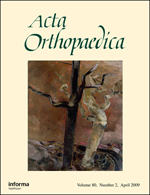
ARTHROPLASTY
Potentially lower migration with all-poly vs metal-backed tibia component in total knee arthroplasty
This report has been verified
by one or more authors of the
original publication.
Acta Orthop. 2018 Aug;89(4):412-417. doi: 10.1080/17453674.2018.1464317
60 patients scheduled for total knee arthroplasty were randomized to either an all-polyethylene tibial component or metal-backed tibial component. Primary outcome was maximum total point motion of the tibial component over 2-year follow-up, while clinical scores and incidence of adverse events were secondary outcomes. Two-year maximum total point motion of the tibial component was significantly lower in the All-Poly group compared to the Metal-Backed group. Clinical scores, including the Knee Injury and Osteoarthritis Outcome Score, Knee Society Score, and the Forgotten Joint Score, did not significantly differ between groups after 2 years.
Unlock the full ACE Report
You have access to {0} free articles per month.Click below to unlock and view this {1}
Unlock NowCritical appraisals of the latest, high-impact randomized controlled trials and systematic reviews in orthopaedics
Access to OrthoEvidence podcast content, including collaborations with the Journal of Bone and Joint Surgery, interviews with internationally recognized surgeons, and roundtable discussions on orthopaedic news and topics
Subscription to The Pulse, a twice-weekly evidence-based newsletter designed to help you make better clinical decisions
Exclusive access to original content articles, including in-house systematic reviews, and articles on health research methods and hot orthopaedic topics
Or upgrade today and gain access to all OrthoEvidence content for just $1.99 per week.
Already have an account? Log in


Subscribe to "The Pulse"
Evidence-Based Orthopaedics direct to your inbox.
{0} of {1} free articles
Become an OrthoEvidence Premium Member. Expand your perspective with high-quality evidence.
Upgrade Now













































































